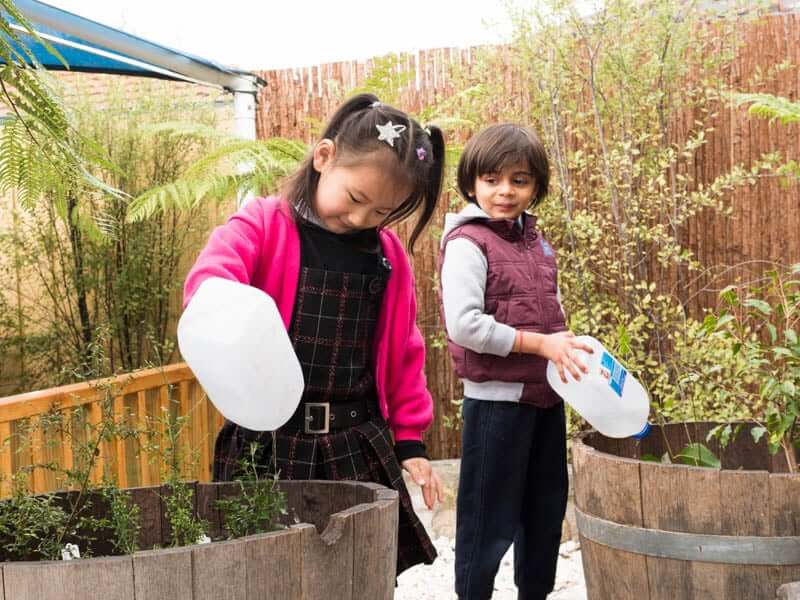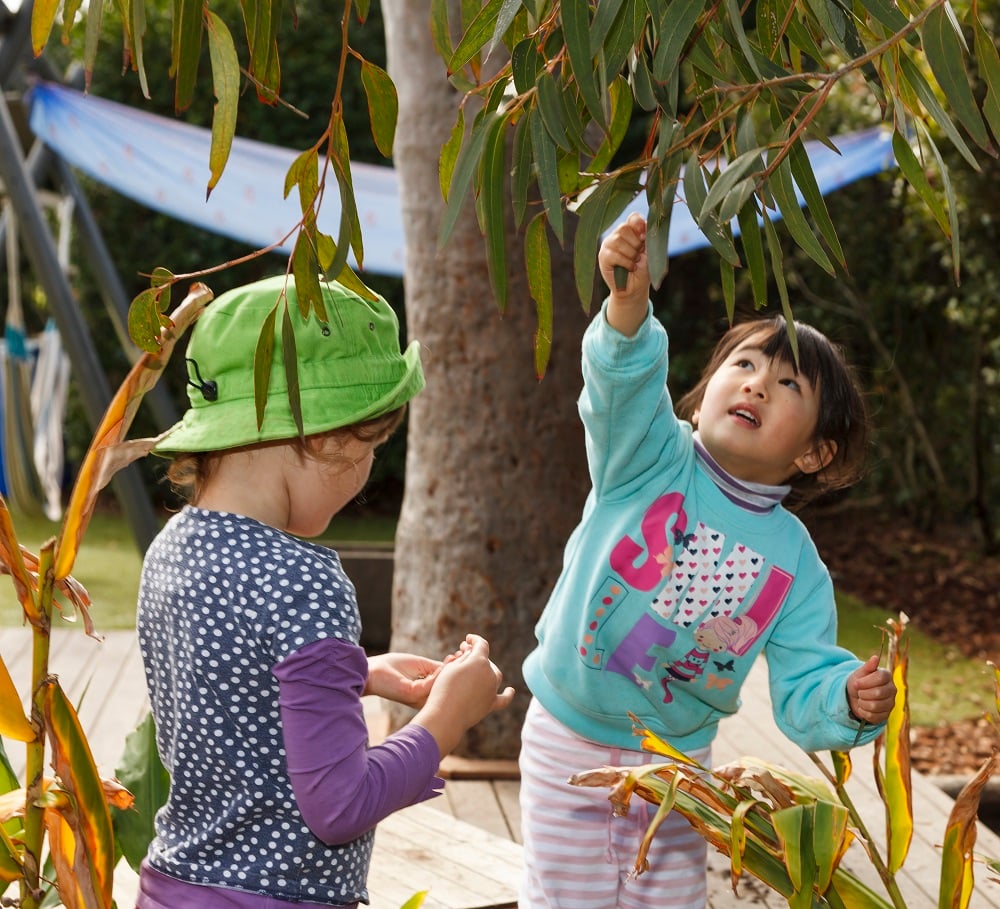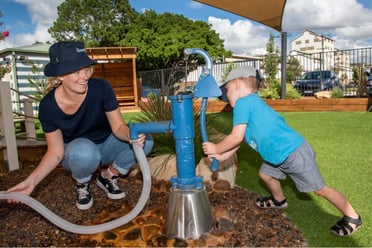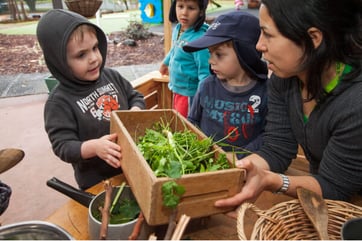Cultivating STEM skills in the early years with inquiry-based exploration
By Lena Hammond
With days becoming longer and the weather increasingly sunnier and warm, springtime for many early education services brings the opportunity to engage children in more outdoor play and experiences with various life science lessons.
Building educational garden beds where children sow flower and vegetable seeds, watching them sprout and grow over time, are often used as an important way to spark conversations about the food we eat.
Establishing a native beehive and constructing ‘bug hotels’ with bamboo and twigs introduces children to explore the world of minibeasts. But these gardens and beehives are not only a place for valuable science lessons. They can also be a rich environment to incorporate experiences in technology, engineering and maths – fields collectively known as STEM.
Global challenges such as climate change and Covid-19 have highlighted the importance and value of an educated and prepared STEM workforce for solving the problems of the future. So while these beehives and gardens are growing flowers and vegetables, so too are they growing Australia’s future resilience and prosperity.
So how can educators make the most out of these springtime activities and ensure children are building skills across all STEM disciplines? The ideas below are not exhaustive but will give you an idea of how to cultivate strong STEM skills (and vegetables).

Engineering
Support children to think and act as engineers as they plan, design and build their bug hotels or support structures in the garden for various plants.
- What is a bug hotel? What kind of minibeasts might take up residence? How big are they and how much room do they need? Research books, magazines and find insects in other areas of the garden for inspiration.
- As the tomatoes and sunflowers grow, they will need support. What kind of shape structure will help support tomato plants when there are large fruits weighing heavily on the vine? Are there some shapes that are stronger than others? Will the sunflowers need the same type of support? How tall will it need to be?
Design and planning. Help children draw a blueprint of their design and/or build a prototype with blocks or Lego. Prompt questions about specifications such as “How many pieces of bamboo will you need? How long will the pieces be?” Let their design imaginations go wild but continue to check back in on their research to see if their design ideas will meet the requirements (do the sunflowers really need 10-metre-high support?)
.jpg?width=5184&name=Saltwater_childcare%20(3%20of%2016).jpg)
Technology
Encourage children to evaluate garden technology, finding ways for work to be more efficient and effective with tools and determine which tools are the best for each job.
- Involve families by asking them to bring in their garden tools. Children can look at and investigate all the various shapes and sizes of trowels, pruning shears, rakes and watering cans. Compare a range of secateurs with straight or curved blades, long or short handles and consider with the children what design aspects of these tools make them useful for particular jobs.
- How will the garden be watered? Which watering can should be used, the big one or the small one? The big one might be obvious but allow the children to try - can they carry a large, full watering can far? Is there another tool that could be used to carry a heavy watering can? Or perhaps the children can pass it to each other one by one to get to the garden. Is this method useful or are smaller watering cans better? Why? Why not?
Maths
Support children’s development of logic and mathematical thinking such as quantities and space when planning what to grow and what you will harvest. Encourage discussions about equivalence, partitioning and distributing and comparing quantities.
- Read seed packets with the children and help to measure space between rows of seeds to be planted with a rough guide such as a hand. How many hand spaces should be between rows? Is it the same when using an adult hand?
- Do all plants need the same space? Can the children guess how big a plant may grow by the amount of space the seed packet recommends? What might happen if too many plants or seeds are put in the recommended space?
- How will you share the harvest equally? If 20 carrots grow and there are 10 children, how many carrots will each of the children get? What would happen if another 10 children wanted carrots also? Would each child get more, fewer or the same number of carrots? How do you know?

Science
Introduce children to scientific research methods, testing hypotheses with experimental trials, manipulating variables, and conducting scientific observations.
- Collect data from the outdoor space. What kinds of minibeasts can be found? How many of each type are found? Can the minibeasts be sorted into different groups according to their features – number of legs, eyes, wings, shells etc?
- What type of habitat does each of the minibeasts inhabit? Under rocks? Within lush leaves? Can these naturalistic observations guide thoughts on what kind of minibeasts will inhabit their bug hotels?
- When planting and growing seeds, set up experimental trials that will test different growing conditions and see which is best. Compare variables such as the amount of water, sunlight or types of fertilizer or other substances.
Why is STEM so important in early childhood education?
Going beyond knowing how to count or recognising the alphabet – the traditional skills thought to help children transition to school - early STEM education enables children to become confident and involved learners as they move into primary school and beyond. Keen observation skills, critical thinking and problem-solving are inherently part of STEM inquiry but also essential to all areas of evolving education curriculums that focus more on applying knowledge rather than remembering knowledge.
Nurturing the innate curiosity of young children and helping them construct meaning from their explorations with the world around them underpin early STEM education, building metacognitive skills and fostering positive learning dispositions in their future school years. Hands-on explorations in co-constructed environments help children cultivate responsibility, independence, self-confidence and resilience – all skills vital to successful and enjoyable transitions to school.
How to engage children in Enquiry Based STEM
Observing and listening to children in their everyday activities is first and foremost to understanding where their interests lie. Following children’s interests is crucial in building motivation to embark on a scientific exploration. Educators can support STEM inquiry by asking questions that prompt children to think about what they know already, what they expect might happen during activities and encourage children to try different ideas.
Educators can foster STEM learning by role-modelling genuine interest, actively participating and allowing children to create their learning journeys. Educators can become the lab assistants for the little scientists! Providing a rich learning environment is important to help stimulate explorations and discussions. Building your own knowledge through professional development such as Little Scientists can help build resources and strengthen curriculum planning.
Addressing educators lack of confidence in STEM learning areas
Sometimes educators have preconceived ideas about STEM and are often afraid of not knowing the answers to big questions that children have and of “getting it wrong”. One of the best messages for educators is that developing STEM skills is the key to early STEM education – not the acquiring of STEM knowledge itself. It is both unrealistic and unimportant for children to understand the laws of thermodynamics, nor would this knowledge benefit educators in being able to deliver high quality STEM education.
However, educators could definitely pick up on a discussion about how warm it is getting outside and how we keep ourselves cool in summer – is a thin cotton shirt and a hat enough? Is a fan better? Does air conditioning work as well outside as it does inside? What is the quickest way to make a cool drink of water? How long does it take for my water bottle to freeze? How long does it take for ice cubes to melt in a cup of water?
These are all small curiosities that can spark potential research questions that children and educators can delve into together. By noticing STEM opportunities in everyday activities, educators can help children hone in on their research skills and practise hypothesising, trial and error, discussions and documenting their scientific explorations.
Other potential missed opportunities for teaching STEM
Water play in the summer months has got to be one of the most under-utilised STEM learning opportunities in the early education sector but also the most beloved. Troughs of water, buckets, cups, and bits and bobs such as pebbles or gumnuts offer so many chances to explore STEM concepts such as gravity, density, solids and liquids, buoyancy and displacement, evaporation, volume and measurement and much more.

Engineering and mathematics skills can be encouraged by building aluminium foil boats and seeing how many marbles it can carry until it sinks. Providing PVC pipes (especially if they are clear) allow children to explore flow of water. They can be challenged to see if they can make water flow upwards.
Evaporation is fun to explore, particularly on very hot days, when water paintings on warm bricks can evaporate almost instantly. Involving ice adds another dimension to understanding the different states of water.
Making bubbles with varying solutions or using bubble blowers of various shapes allows children to explore viscosity, tension, emulsion and suspension. These ideas are only skimming the surface (pun intended), which is why Little Scientists’ hands-on Water workshop is the foundation point for educators wanting to learn more about inquiry-based STEM education.
These playful, hands-on experiences in engineering, technology, maths and science are rich learning opportunities that lay foundations for positive learning dispositions. They strengthen scientific habits of collaboration, critical thinking and problem solving. Educators who extend everyday activities such as bug hotels and gardens are helping children develop STEM fluency.
Similar to learning a language, STEM fluency is established with early beginnings and immersion in daily life. Hands-on, inquiry-based experiences in the early years that engage children in multiple spaces, times and activities empowers children to truly grow concepts and ways of thinking. And in this case, they might also grow a carrot.

Keen to learn more? Little Scientists Australia is a professional development program with early STEM workshops held in multiple locations across Australia and online. Visit https://littlescientists.org.au/ for more information.







